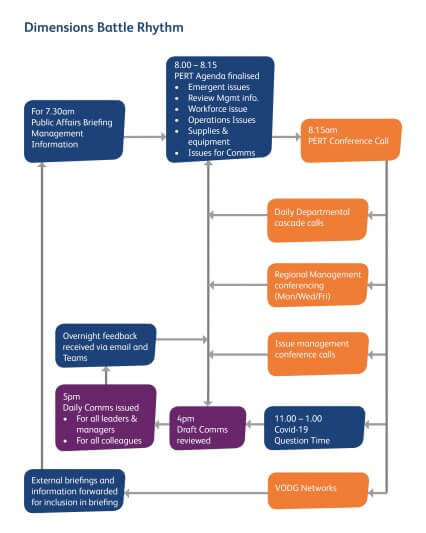Coronavirus days part 2: Battle Rhythms
“A battle rhythm.” This was how one reader described the working pattern I shared in last week’s blog and which, on request, today’s blog expands on. If you’re not interested in the practice of leadership during Covid-19, look away now.
Google tells me that a battle rhythm is a well-known military term describing (amongst other things,) “A deliberate cycle of command, staff and unit activities intended to synchronise current and future operations.”

Further reading highlighted what we’ve come to appreciate about our new ‘battle rhythm’: a widely adopted rhythm helps colleagues work in harmony and support one another at a time of crisis. It helps people focus on what’s in front of them, knowing their views are being captured and considered and that they have a single source of truth.
Having discovered that what we’d adopted wasn’t original (or rocket science) I thought I’d share more about what we’ve found incredibly helpful over the past few weeks.
Our battle rhythm starts early with an external briefing and a review of the previous day’s management information.
The briefing brings together government announcements, legal points and sector insights (via the increasingly useful VODG Hubs as well as our various networks.)
Our daily management information tells us:
- how many colleagues are currently not working due to Covid-19
- how many operational colleagues and people we support are in self-isolation
- how our IT infrastructure is coping with the demand we’re placing on it
- our cash balance and cash recovered the previous day.
Weekly management indicators will soon additionally tell us:
- how much business we’re invoicing per week
- how many services were above our agency threshold the preceding week
- Covid-19 related incidents and safeguarding risks.
The first key event of our day is the PERT (Pandemic Emergency Response Team) meeting. Early on I decided not to chair this, and I’ve grown accustomed to not controlling discussions and driving the pace. (Anybody who’s ever worked with me will know how difficult I found that.)
Now is not the time for a CEO to be buried in detail. Throughout the meeting our internal comms lead is noting and clarifying content for our daily briefings.Following PERT a range of cascade briefings are held, work is allocated and various leads engage with the VODG Hubs. Key issues are fed either to our internal comms lead or to the PERT agenda planner and our daily actions log is kept up to date.
We are changing how we work and making decisions we wouldn’t ordinarily make, taking approaches that sometimes challenge longstanding and cherished principles. By way of example, we’ve strived to include people we support and family members every time we recruit a new colleague. We’re finding that nigh-on impossible now as we have to recruit at pace to get through this crisis. Putting that aside is something I never thought we’d do.
In some instances we’re sailing close to regulatory lines. So through our daily log we keep a clear record of our decisions and how we assessed the risks in agreeing a new way of working. To date we’ve logged over 140 changes, in the process stripping away elements of policy in the interests of short-term efficiency. It will be interesting to see what re-emerges as important in the aftermath of Covid-19.
We convene three Covid-19 Question Times each week (thanks for the suggestion, Anna Galliford and Fitzroy.) QT focusses on organisational policies and the implications of external announcements, not on service-specific issues which are handled through line management. It provides a direct connection from our 7000-strong workforce to our Health & Safety team, and hence to PERT.
Our daily briefings are drafted, reviewed and most importantly issued no later than 5pm. They include large amounts of resources – for the people we support, for colleagues and for families – to help them get on with having good days and managing effectively through the crisis.
We happily share good stuff created by others, and others can make use of many of our resources, here.As I mentioned in last week’s blog this regularity has helped colleagues stay focussed on the work in hand, knowing that evolving guidance and instruction is coming to them later in the day. As the day draws to a close issues are entered into the PERT agenda planner and our actions log is updated.
Our Board receive both daily briefings – for leaders and managers, and for all colleagues. This has proved a great way of providing assurance. Our Chair has been clear from day 1 – the Board will support me to lead the organisation and avoid placing any unnecessary burdens on my colleagues. Sharing the briefings is certainly helping achieve that.
It took us about three meetings to establish the key parts of our Battle Rhythm. It continues to evolve as we learn from our own experiences and from others’. I hope other leaders find this text, and the flowchart below, useful. In return, as an organisational leader, what would you share of your own working practice?




